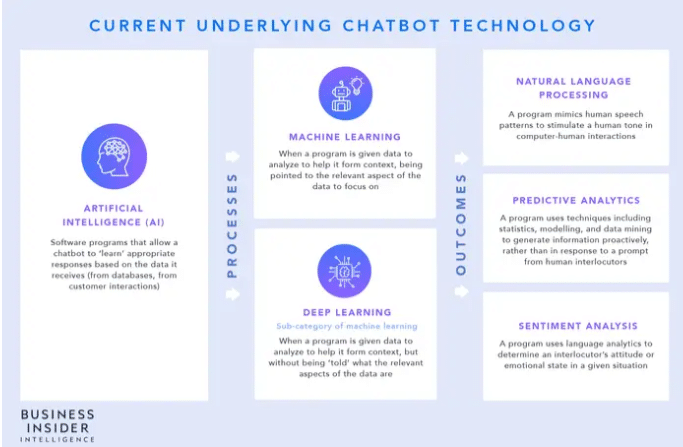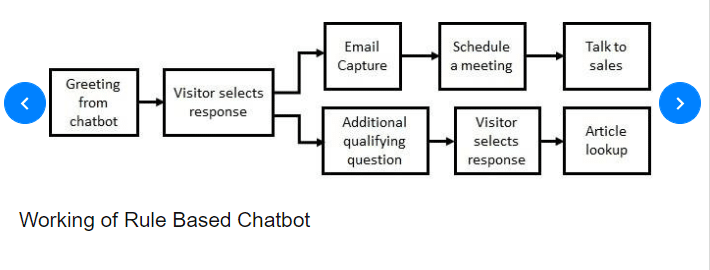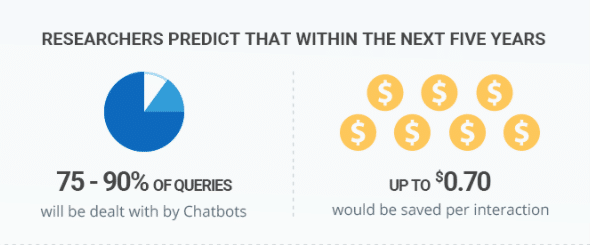Artificial intelligence (AI) has changed how we use the internet, both from a consumer and a digital marketing point of view. And chatbots, in particular, have taken the world of eCommerce by storm. Some experts predict the eCommerce chatbot market will grow to $9.4 billion by 2024 – an annual growth of 29.7% -with chatbots in the customer service sector expected to grow the fastest.

The availability of developer tools and services is enabling e-commerce companies to develop their own chatbots. This has accelerated their adoption and led to a race to create better, more intuitive bots, that are easy to implement. Not to mention being capable of having more successful interactions with consumers.
Successful chatbots have the ability to drive conversations – and drive customers along the sales funnel – by replicating, as closely as possible, real human interaction.
What is a Chatbot?
“Chatbots are artificial intelligence systems that interact with users via messaging, text, or speech.”
Chatbots are computer programs that stimulate conversation with online users for them to complete a service. Chatbot widgets and windows pop up everywhere from social media—e.g. Facebook and WhatsApp—to eCommerce websites, enabling brands and eCommerce businesses to reach their target audiences through different APIs.
Chatbots can be deployed for all kinds of purposes. They can be useful in marketing strategy or used for payments and processing. Where they really come into their own in adding efficiencies, though, is in customer service.
Chatbots offer ways to instantly communicate with customers on multiple platforms or online eCommerce stores. They use AI to infer customer preferences and offer visitors personalised experiences.
Ecommerce chatbots can be designed to:
- Help complete a buyer’s purchase
- Offer product recommendations
- Provide customer support
Chatbot Examples in Ecommerce
The future for eCommerce chatbots is immense – especially considering that the technology is still relatively new, and some online retailers are starting to use them more creatively than others.
Here are a few ways e-commerce chatbots are currently helping companies connect with customers:
1. Staples.
Staples is an online retailer that sells office equipment. They use Facebook Messenger to deliver product suggestions to customers, based on their previous brand behaviours. Staples’ Facebook chatbot also enables customers to complete purchases direct from the chat.

2. H&M.
H&M is a well-known clothing retailer. They created a chatbot on Kik to ask customers questions around their style and offer them photo options to select from. Based on this input, the bot can create individual fashion profiles and make suggestions for suitable outfits and direct the user to the checkout.
Customers can create outfits from the chatbot’s suggestions, and browse and vote on other H&M customers’ fashion creations—enabling them to have a fully interactive online shopping experience.
3. eBay.
The eBay chatbot is a popular and advanced example. Built for the Google Assistant, eBay’s chatbot can be used with Google Home or on the phone. The bot will answer customer queries about products and drive the sales process. For example, it can answer users queries around the lowest price options or the best new products – across all eBay’s worldwide sites.
The interface is designed to help users navigate many product categories and can be accessed by saying “OK Google, let me talk with eBay”.

Benefits of Using Chatbots in Ecommerce
1. Immediacy.
Customers expect immediate feedback and customer service, 24/7. Chatbots can provide an ‘always on’ service and answer queries at any time of day from anywhere—even during holidays and weekends when there’s no one in the office. Even if a chatbot isn’t advanced enough to solve tough questions, it’s there to give customers a personalised response to their concerns, thus adding layers of brand awareness and loyalty optimisations.
2. Neutrality.
Chatbots can interact with customers on an emotion-free basis. In some ways, this makes them the perfect ‘employees’ as they can’t get angry or frustrated with customers. This lack of emotion could, in theory, backfire since customers want to know real human beings are hearing them. There are more positive applications, though, and the more advanced a bot, the more positive side to this interaction.
3. Personalisation.
One of AI’s chief benefits is it’s the ability to synthesise data to personalise customer experiences. For example, chatbots can offer optimised product recommendations based on previous customer interactions with the online store. A good example of that comes in the shape of Amazon, which brings up tailored product recommendations when you’re on the site.
4. Reduction in costs.
Chatbot services reduce costs and speed up response times, enabling customer service agents to take on more challenging core business-related activities.
People Want to Shop With Messenger Apps
Most customers are already familiar with SMS and instant messaging apps in social networks. They are now also becoming accustomed to interacting with chatbots in retail and customer service environments. And many appreciate the fact that chatbots are a level above email when it comes to getting an immediate response.
And recent research indicates that many consumers enjoy communicating with AI in an online retail situation. Not only do they like the fact they get a response in real-time, but they can also often find the answer to their common questions without needing to involve anyone else.

The rewards for eCommerce businesses, however, lie in the fact that not only are customers happy to have their questions answered by messenger bots, but they’re also increasingly willing to purchase items this way. 47% of users said they’re open to purchasing items via a bot.
More businesses are using bots.
Of the numerous applications out there using AI, chatbots are the most popular and are widely considered the future of customer service. A recent survey revealed that 50% of businesses plan to spend more on chatbots than mobile messaging platforms.
More and more companies, including LinkedIn, Starbucks, British Airways, and eBay, to name a few, have been investing time and money into the development of chatbot technology. And lots of SMEs and startups have followed in their wake.
Chatbots aren’t just for cutting edge tech companies like IBM. Many brands and online retailers are using them to communicate with their customers and boost sales.
How do Chatbots Work?
Chatbots are basically categorised in two ways: bots with pre-decided functions and bots that keep learning with certain algorithms. Learning bots have differing levels of complexity, depending on the algorithms used. Simpler ones are fed specific information and have particular options available.
Chatbot building companies are generally third-party companies that use AI tech to help businesses deploy their own chatbot across a platform. Native chatbots are built by the platform or app they operate—e.g., Apple’s Siri or Google Assistant.
1. Rule-based chatbots.
Rule-based chatbots are also known as ‘decision tree bots’. As the name suggests, they use defined rules as the bases of problem-solving, for problems the chatbot is familiar with and can deliver solutions to. As with a flowchart, rule-based chatbots map out conversations in anticipation of what customers might ask.
They can use simple or complex rules, but they cannot answer questions outside of these rules, and they don’t learn via subsequent interactions. They just work for the rules for which they’ve been trained.

Chatbots that function based on sets of rules can be quite restrictive. That’s because they can only respond to specific commands, rather than interpreting a user’s natural language.
They can be a good idea for eCommerce businesses that only expect to generate a set of simple queries referring to limited types of information. Also, rule-based chatbots have guard rails that guarantee they’ll react predictably in every situation. Rule-based chatbots are also:
- Faster to train and less expensive than AI chatbots.
- Easy to integrate with legacy systems.
- Able to streamline handover to a live agent.
- Accountable and secure.
- Able to incorporate interactive elements and media.
- Not restricted to text interactions.
Rule-based chatbots are similar to an IVR menu that narrows the process as you proceed through a phone call. For example, when the robot asks you to ‘press one for English’, etc. Options are narrowed down until the user receives the service they’re looking for.
2. AI chatbots.
AI chatbots use machine learning to understand the context and intent of a question before answering. These bots generate their own answers to more complex questions and use more natural language responses. The more AI chatbots are used and trained, the more they learn and interact with customers.

AI chatbots work well for eCommerce companies that have lots of data. Even though they take longer to train initially, they should save money in the long run. AI chatbots are also capable of:
- Continuous improvement as more data is collected
- Understanding patterns of behaviour
- Making more decisions based on prior experience
- Understanding many languages
How do I Build an eCommerce Chatbot?
There are two ways to create a bot; either use a service provider or build one yourself. If your eCommerce business is developer-focused, creating a native chatbot could be for you. However, for most organisations, it will make more sense to call on the services of an eCommerce chatbot provider.
It’s relatively easy to create a customised bot without coding, using one of the many chatbot builders on the market. You can build a chatbot with any number of automation possibilities, including a bot to answer your FAQs, bots that can provide order and shipping statuses, and—for eCommerce stores—a bot to engage with website visitors.
A provider like Collect. chat can create a bot that can run 24/7, and once set up it’s all good. Simply follow the tutorials to get started, and then no further configurations or maintenance are required. It can also integrate with third-party apps, including Gmail.
HubSpot also has a Chatbot Builder that allows you to have unlimited conversations with customers and automate common questions and problems.
No coding knowledge is required; you simply select an appropriate template and add elements to match your individual requirements. It’s also possible to start from scratch and build a totally custom eCommerce chatbot.

How to Measure Your Chatbot’s ROI
The most important reasons to use eCommerce chatbots are improved customer service quality and cost savings. Chatbots don’t lose productivity, no matter how much you use them, so they promise to provide high long-term ROI in eCommerce companies. Some estimates reveal that businesses could see savings of up to $20 million globally after implementing eCommerce chatbots.
When measuring the ROI of chatbots, you need to weigh the time it takes to converse and resolve issues, and the total time to exit.
Here are some steps to take when calculating the ROI of a chatbot:
- Identify eligible queries. Pin down which queries your eCommerce business currently receives via live chat. Then, identify the top simple queries a chatbot could resolve.
- Calculate how many chats deal with eligible queries. What percentage of chats are simple (the questions bots could answer) vs complex questions (those requiring agent input).
- Calculate how long agents spend on eligible chats. What is the estimated handle time for simple (chatbot-ready) enquiries?
- Estimate the annual cost of handling eligible chats. Multiply an agent’s hourly pay by hours spent on these types of interactions. To get an annual cost to multiply monthly costs by 12.
- Compare costs. Compare your annual costs with your quoted eCommerce chatbot cost to see how chatbots stack up.

Bot-building platform analytics
It’s essential to be able to access analytics for chatbots. Otherwise, you won’t know how potential customers are behaving with your bot. Or whether things need to be changed or tweaked to make them more effective.
The most successful bots are constantly adapting and revising their conversation flows in response to how users interact with them.
Some key metrics to build into your bot platform
User metrics: For example, how many repeat users are using chatbot alongside new customers? How many active users and engaged users (users who communicate with the bot) send and receive messages? User sentiment can also be captured by performing sentiment analysis to categorise messages as positive, neutral, or negative.
Message metrics: These can measure, for example, the number of times the bot initiates interactions, the number of messages a bot sends in an interaction, the number of messages sent by users (this will tell you if a user is engaged with a chatbot), and missed messages.
Outside platform analytics
There are quite a few chatbot analytics platforms to choose from. Each has its own strengths and weaknesses, depending on each eCommerce company’s use case.
When selecting a provider, it’s important to choose one that measures what you want to measure; retention, lead generation, or conversion rates, for example. That’s rather than just bombarding you with excess data. Many of these platforms offer free options so you can trial them and see which you prefer. Here are a few to consider:
1. Dashbot.
Dashbot has several useful features, including being able to provide an intent mapping to help see how bots are matching messages to intent categories:

Dashbot is one of the largest chatbot analytics platforms. Using bot-specific metrics, you can gain a deep understanding of the conversations your users are having and the type of questions they’re asking.
2. Botanalytics.
Botanalytics is good for tracking individual user lifecycles, charting the length and date of conversations, and the number of conversations per user. This can be helpful when trying to identify your top eCommerce chatbot users. Botanalytics also provides transcripts of conversations.
3. Facebook analytics.
With Facebook’s analytics platform, you can be up and running with no coding knowledge at all. This only applies to bots on Facebook (as you would imagine). The analytics are not too sophisticated, but this is a fast and easy way to get started with chatbot analytics.
Conclusion
Consumers are demanding. Today, they want around the clock service for assistance. In every sector, from banking and insurance to health and wellness, companies are rushing to develop chatbots and virtual assistants to answer their questions.
They’re proving especially useful to companies in the eCommerce sector, to allow customers to interact with a brand on their own terms, thereby reducing abandoned carts’ incidences.

While chatbots are incredibly helpful to companies, they can never be a complete replacement for human support. They can’t be trusted to deal with sensitive issues, for example. When assessing the type of eCommerce chatbot that’s right for you, take some time to understand your goals. I.e., what are you leading people to do? Maybe you want a chatbot to act as a conduit for FAQs or a bot to funnel users to human agents?
You could start with a simple rule-based chatbot that answers basic customer service inquiries and then expands to more complex tasks such as helping customers find the right products based on their preferences.
When adopting chatbots for your eCommerce operation, make sure you also incorporate a way to collect feedback about them. This will determine whether your customers like or loathe your eCommerce chatbot and, based on this information, you can make the requisite changes required for optimisation.
Originally published Feb 16, 2021, updated Mar 11, 2021

